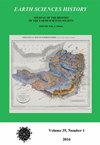EARLY THEORIES AND PRACTICALITIES ON GOLD OCCURRENCE IN AUSTRALIA
IF 0.6
4区 哲学
Q4 GEOSCIENCES, MULTIDISCIPLINARY
引用次数: 0
Abstract
The discovery of gold in Australia forced many changes to theory on the occurrence and origin of gold deposits. Initial discoveries appeared to confirm existing ideas on the global distribution of gold-bearing terrains. Later discoveries and research would show that this confirmation was largely coincidental, but nevertheless helpful in early prospecting. Prior to the first Australian gold rush, theoretical predictions of payable gold were made by Sir Roderick Murchison and Rev. W. B. Clarke based on knowledge of accidental gold finds and geological analogy with known areas of significant gold occurrence, particularly the Ural region in Russia. These predictions were overwhelmed when Edward Hargraves, realised he might be able to spark a gold rush that would prove the existence of payable gold. Hargraves travelled to the Bathurst region of New South Wales where numerous gold finds had already been made and with local guides, prospected Lewis Ponds Creek and the Macquarie River. He demonstrated the methods of alluvial mining, to John Lister and William and James Tom enabling them to find sufficient alluvial gold to initiate a gold rush. The crowd of attracted diggers demonstrated the existence of a payable goldfield. The unstoppable first rush resulted in the pragmatic introduction of government regulation and administration to allow alluvial gold mining. Other discoveries of payable goldfields quickly followed. As the local scientific expert on gold, W. B. Clarke was commissioned to conduct two extensive surveys of the goldfields between 1851 and 1853. Clarke also drew on his geological knowledge to provide practical advice to the thousands of prospecting gold diggers. Gold-bearing quartz reefs and lodes were discovered, but it was predicted that these could not be mined economically. Theory also predicted that the reef gold would not continue to depth. Practical observations and mining experience from the numerous discoveries led to revision of the widely held dicta on gold occurrence. Alluvial gold was found in a range of settings, including the recent drainage and ancient and buried leads. A wider variety of rock types was recognised as favourable for gold. Different styles of reef gold were identified and found to be economically mineable to great depth. Evolving ideas on the origin of gold deposits were widely discussed, tested, and refined. Of the many players involved in the early discovery of gold in Australia, Clarke, Hargraves and Murchison probably had the greatest overall influence in terms of theoretical predication and practical outcomes that initiated the Australian gold-mining industry.澳大利亚金矿床的早期理论与实践
澳大利亚发现的黄金迫使人们对金矿床的发生和起源理论进行了许多改变。最初的发现似乎证实了关于含金地形全球分布的现有观点。后来的发现和研究表明,这一确认在很大程度上是巧合,但仍有助于早期勘探。在第一次澳大利亚淘金热之前,Roderick Murchison爵士和W.B.Clarke牧师根据偶然发现的黄金的知识以及与已知重要黄金产地(特别是俄罗斯乌拉尔地区)的地质类比,对应付黄金进行了理论预测。当爱德华·哈格雷夫斯意识到他可能会引发一场淘金热,证明应付黄金的存在时,这些预测被淹没了。哈格雷夫斯前往新南威尔士州的巴瑟斯特地区,那里已经发现了许多黄金,并与当地导游一起勘探了刘易斯池塘溪和麦考瑞河。他向约翰·李斯特、威廉和詹姆斯·汤姆展示了冲积采矿的方法,使他们能够找到足够的冲积金来引发淘金热。一群被吸引的挖掘者展示了一块值得支付的金矿的存在。势不可挡的第一次淘金热导致了政府监管的务实引入,允许冲积金矿开采。随之而来的是其他可支付金矿的发现。作为当地的黄金科学专家,W·B·克拉克受委托在1851年至1853年间对金矿进行了两次广泛的调查。克拉克还利用他的地质知识为成千上万的淘金者提供了实用的建议。人们发现了含金的石英礁和矿脉,但据预测,这些石英礁和脉无法进行经济开采。理论还预测,珊瑚礁的黄金不会继续深入。从众多发现中获得的实际观察和采矿经验导致了对广泛持有的关于黄金产状的格言的修订。冲积金在一系列环境中被发现,包括最近的排水系统、古代和埋藏的铅。更广泛的岩石类型被认为对黄金有利。人们发现了不同风格的礁金,并发现它们在经济上可以开采到很深的深度。关于金矿床起源的不断演变的观点被广泛讨论、测试和提炼。在澳大利亚早期发现黄金的众多参与者中,Clarke、Hargraves和Murchison可能在理论预测和实践结果方面具有最大的整体影响力,从而开创了澳大利亚金矿业。
本文章由计算机程序翻译,如有差异,请以英文原文为准。
求助全文
约1分钟内获得全文
求助全文
来源期刊

Earth Sciences History
GEOSCIENCES, MULTIDISCIPLINARY-HISTORY & PHILOSOPHY OF SCIENCE
CiteScore
1.00
自引率
0.00%
发文量
1
审稿时长
>12 weeks
期刊介绍:
Earth Sciences History promotes and publishes historical work on all areas of the earth sciences – including geology, geography, geophysics, oceanography, paleontology, meteorology, and climatology.
The journal honors and encourages a variety of approaches to historical study: biography, history of ideas, social history, and histories of institutions, organizations, and techniques.
Articles are peer reviewed.
 求助内容:
求助内容: 应助结果提醒方式:
应助结果提醒方式:


